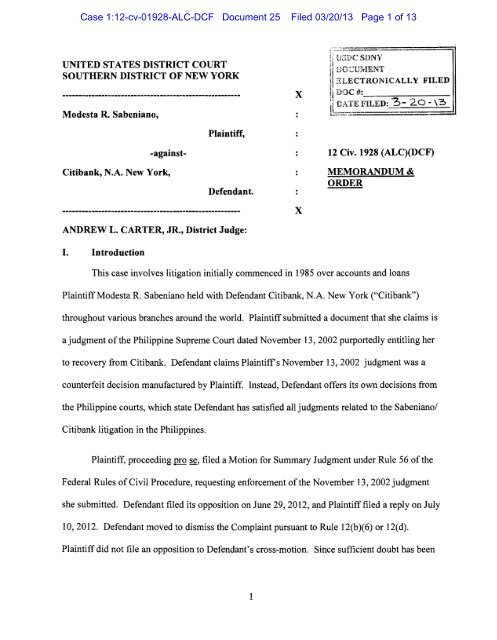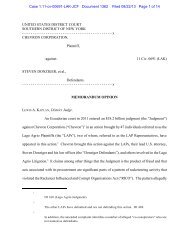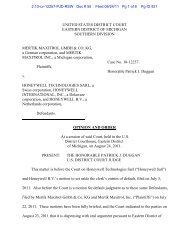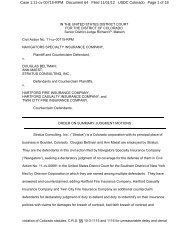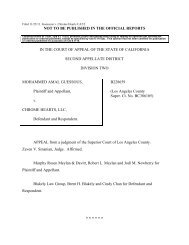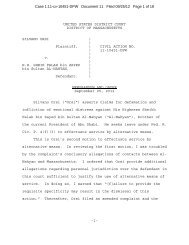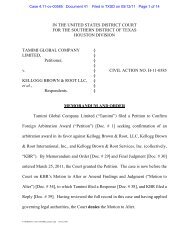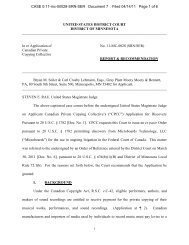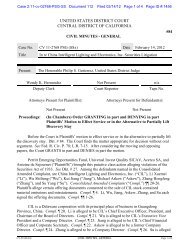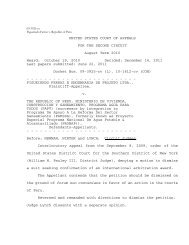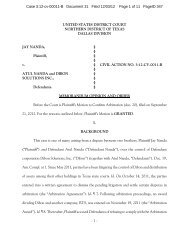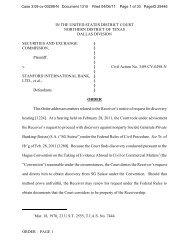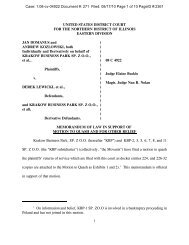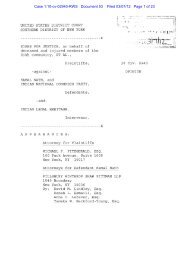Sabeniano v. Citibank N.A. New York (S.D.N.Y. ... - Letters Blogatory
Sabeniano v. Citibank N.A. New York (S.D.N.Y. ... - Letters Blogatory
Sabeniano v. Citibank N.A. New York (S.D.N.Y. ... - Letters Blogatory
You also want an ePaper? Increase the reach of your titles
YUMPU automatically turns print PDFs into web optimized ePapers that Google loves.
Case 1:12-cv-01928-ALC-DCF Document 25 Filed 03/20/13 Page 3 of 13<br />
October 16, 2006 order of the Supreme Court became final and executory on May 31, 2007.<br />
To satisfy the October 16, 2006 judgment, <strong>Citibank</strong> deposited a check for approximately<br />
$400,000 with the Philippine courts. Three Resolutions issued by the Supreme Court, dated<br />
February 4, 2008, June 18, 2008, and August 27, 2008, stated <strong>Citibank</strong> had tendered all amounts<br />
due and had no further obligations pursuant to the October 16, 2006 judgment. The trial court<br />
issued an order on August 4, 2008, noting the Supreme Court had already determined <strong>Citibank</strong><br />
had satisfied all liabilities and agreeing <strong>Citibank</strong> had discharged its obligations to Plaintiff in<br />
accordance with the Supreme Court's decision.<br />
On March 15,2012, Plaintiff filed the instant Complaint, claiming a November 13,2002<br />
judgment ofthe Supreme Court in the Philippines litigation awarded her $13,207,842.02 and<br />
seeking to enforce this judgment against <strong>Citibank</strong>. Plaintiff claims the judgment is a true and<br />
accurate copy ofthe Supreme Court decision. Defendant argues the November 13,2002<br />
judgment was falsified by Plaintiff from a patchwork ofprior and subsequent decisions. After<br />
unsuccessful attempts to locate the judgment submitted by Plaintiff in the court database,<br />
<strong>Citibank</strong> submitted a letter to the Philippine Supreme Court dated April 12, 2011 requesting<br />
verification ofthe decision. By Notice dated July 20,2011, the Supreme Court explained it<br />
never issued a decision dated November 13, 2002 in the <strong>Sabeniano</strong>/<strong>Citibank</strong> case and directed<br />
Plaintiff to show cause "why she should not be cited for contempt of Court for submitting the 13<br />
November 2002 Decision which is spurious." (Prodigalidad Decl., Ex. 3, Dkt. No. 16-5.)<br />
Plaintiff moved for summary judgment, and <strong>Citibank</strong> made a cross-motion to dismiss the<br />
Complaint pursuant to Rule 12(b)(6) or 12(d). Plaintiff requests enforcement of the November<br />
13, 2002 judgment awarding her additional money from Defendant. Defendant requests<br />
3
Case 1:12-cv-01928-ALC-DCF Document 25 Filed 03/20/13 Page 4 of 13<br />
recognition and enforcement of the October 16, 2006 judgment ofthe Philippines Supreme Court<br />
by finding the principles ofres judicata, collateral estoppel, and accord and satisfaction prohibit<br />
Plaintiff from relitigating the case. Additionally, Defendant argues dismissal ofthis case is<br />
warranted due to Plaintiffs submission offraudulent documents to the Court.<br />
III. Discussion<br />
Submissions of pro se plaintiffs should be construed liberally by courts and interpreted to<br />
assert the strongest arguments they suggest. Triestman v. Fed. Bureau of Prisons, 470 F.3d 471,<br />
475 (2d Cir. 2006); Ortiz v. McBride, 323 F.3d 191, 194 (2d Cir. 2003). Accordingly, Plaintiff's<br />
Motion for Summary Judgment is viewed in light ofthe most compelling arguments her<br />
submissions raise.<br />
A. Standard ofReview<br />
Rule 12(d) allows for a Rule 12(b)(6) motion to dismiss to be converted to a motion for<br />
summary judgment under Rule 56 when matters outside the pleadings are submitted to and<br />
considered by the Court and the parties have had a reasonable opportunity to present all material<br />
relevant to the motion. Fed. R. Civ. P. 12(d). While courts should generally give notice to the<br />
parties ofthe intention to convert a motion, explicit notice is not always necessary. Garcha v.<br />
City ofBeacon, 351 F. Supp. 2d 213,216 (S.D.N.Y. 2005); Green v. Doukas, No. 99-7733, 2000<br />
WL 236471, at *2 (2d Cir. Feb. 15,2000) (summary order). "The essential inquiry is whether ..<br />
. [a party] should reasonably have recognized the possibility that the motion might be converted<br />
into one for summary judgment or was taken by surprise and deprived ofa reasonable<br />
opportunity to meet facts outside the pleadings." In re G. & A. Books. Inc., 770 F.2d 288,<br />
295 (2d Cir. 1985). "A party cannot complain oflack ofa reasonable opportunity to present all<br />
4
Case 1:12-cv-01928-ALC-DCF Document 25 Filed 03/20/13 Page 5 of 13<br />
material relevant to a motion for summary judgment when both parties have filed exhibits,<br />
affidavits, counter-affidavits, depositions, etc. in support ofand in opposition to a motion to<br />
dismiss." Id.<br />
Plaintiff filed her Motion for Summary Judgment before the Motion to Dismiss and<br />
Defendant's formal appearance in this case. Plaintiff attached voluminous documents to her<br />
Motion, including multiple notices, orders, and decisions from Philippine courts, accounting<br />
summaries, and newspaper articles. Defendant submitted equally voluminous documents in<br />
support of its Motion, addressing matters outside ofthe Complaint. Plaintiff's reply included<br />
even more documents for the Court's consideration, such as affidavits, repurchase agreements,<br />
and promissory notes. Based on the submissions of both parties, neither can claim they have<br />
been deprived of a full and fair opportunity to address the facts and allegations outside of the<br />
Complaint. In fact, Defendant styled its Motion under Rule 12(b)( 6) or 12( d), indicating it<br />
anticipated conversion. Therefore, the Court will treat the pending motions as cross-motions for<br />
summary judgment.<br />
A party moving for summary judgment has the burden of establishing no genuine issue of<br />
material fact exists, and the moving party is entitled to judgment as a matter oflaw. Fed. R. Civ.<br />
P. 56(c); Scott v. Harris, 550 U.S. 372, 380 (2007); Anderson v. Liberty Lobby, Inc., 477 U.S.<br />
242,250 (1986); Ford v. Reynolds, 316 F.3d 351,354 (2d Cir. 2003). Material facts are those<br />
that may affect the outcome of the case. Anderson, 477 U.S. at 248. An issue of fact is<br />
considered "genuine" when a reasonable finder of fact could render a verdict in favor ofthe non<br />
moving party. Matsushita Elec. Indus. Co., Ltd. v. Zenith Radio Corp., 475 U.S. 574, 587 (1986)<br />
(HWhere the record taken as a whole could not lead a rational trier of fact to find for the non<br />
moving party, there is no
Case 1:12-cv-01928-ALC-DCF Document 25 Filed 03/20/13 Page 6 of 13<br />
In considering a summary judgment motion, "the court's responsibility is not to resolve<br />
disputed issues of fact but to assess whether there are any factual issues to be tried, while<br />
resolving ambiguities and drawing reasonable inferences against the moving party." Knight v.<br />
U.S. Fire Ins. Co., 804 F.2d 9, 11 (2d Cir. 1986) (citing Anderson, 477 U.S. at 248). Ifthe Court<br />
recognizes any material issues of fact, summary judgment is improper, and the motion must be<br />
denied. Eastway Constr. Corp. v. City of<strong>New</strong> <strong>York</strong>, 762 F.2d 243,249 (2d Cir. 1985).<br />
B. Authenticity ofPlaintifFs November 13,2002 Judgment<br />
Defendant alleges the November 13, 2002 decision awarding Plaintiff judgment against<br />
<strong>Citibank</strong> was falsified by Plaintiff and provides compelling evidence to support its argument.<br />
Defendant contends the decision contains several inconsistencies and inexplicable departures<br />
from the form of authentic Supreme Court rulings. For example, in the first paragraph, the<br />
decision initially references a petition for certiorari that is before the court but later refers to a<br />
petition for review that has not yet been filed. (Prodigalidad Decl., Ex. 1, Dkt. No. 16-1.)<br />
Additionally, page two contains the heading "The Antecedent Facts" under which no facts are<br />
listed but instead, the phrase "IN VIEW OF THE FOREGOING" followed by the dispositive<br />
ruling. (Id.) Most convincingly, Defendant points out the decision, which was dated November<br />
of2002, refers to entry ofjudgment having been made on January 3, 2003, several months in the<br />
future. (IQJ<br />
In its supporting exhibits, Defendant submitted a Notice from the Supreme Court dated<br />
July 20, 2011, which states,<br />
On 11 April 2011, this Court issued a Resolution denying the request of petitioner<br />
Modesta R. <strong>Sabeniano</strong> for authentication of the alleged 'Decision dated 13<br />
November 2002' on the ground that 'there is no Decision dated 13 November<br />
2002 rendered by the First Division in this case.' ... WHEREFORE, the Court<br />
6
Case 1:12-cv-01928-ALC-DCF Document 25 Filed 03/20/13 Page 7 of 13<br />
resolves to REQUIRE petitioner Modesta R. <strong>Sabeniano</strong> to EXPLAIN within ten<br />
(l0) days from notice why she should not be cited for contempt of Court for<br />
submitting the 13 November 2002 Decision which is spurious.<br />
(Prodigalidad Decl., Ex. 3, Dkt. No. 16-5.) Notwithstanding the suspect nature ofthe November<br />
13,2002 decision submitted by Plaintiff, Defendant acknowledges the Supreme Court issued a<br />
Resolution of the same date terminating Plaintiffs appeal for failure to perfect within the<br />
proscribed time period. Defendant provided a copy of the November 13, 2002 Resolution<br />
verifying Defendant's contention as to the content of that Resolution. (Prodigalidad Decl., Ex.<br />
2C, Dkt. No. 16-2.) Defendant opines that Plaintiff copied and pasted different parts of various<br />
prior and subsequent decisions to manufacture the November 13, 2002 judgment.<br />
Plaintiff claims she was not given a copy of the disputed November 13,2002 judgment<br />
until she terminated her legal counsel in the Philippines case in March of 20 11, at which time she<br />
immediately asked the Supreme Court for authentication of the decision. Complicating her story<br />
further, Plaintiff submitted what she claims to be the certification of the November 13,2002<br />
judgment. (PI. Reply Mem., Ex. AC-2 p. 31, Dkt. No. 23-2.) The certification, which states it<br />
was issued at the request of Plaintiff, is dated December 20, 2002. Not surprisingly, there is no<br />
explanation as to how Plaintiff could produce a certification issued at her request in December of<br />
2002 for a decision that she was unaware ofuntil March of2011. Moreover, the certification is<br />
from the Court ofAppeals but attempts to certifY a decision of the Supreme Court.<br />
The facts and supporting evidence Defendant has submitted indicating the November 13,<br />
2002 decision was falsified are persuasive. Aside from the inconsistencies and non sequiturs in<br />
the document, this Court cannot overlook the July 20, 2011 Notice from the Philippine Supreme<br />
Court plainly stating it did not issue a November 13,2002 decision in the <strong>Sabeniano</strong>/<strong>Citibank</strong><br />
7
Case 1:12-cv-01928-ALC-DCF Document 25 Filed 03/20/13 Page 8 of 13<br />
case. Plaintiffs story, on the other hand, is riddled with implausible contentions about recently<br />
discovering the decision but then producing a certification from a different court that is over<br />
twelve years old. While it is well-established that credibility should not be determined on<br />
summary judgment, Hayes v. <strong>New</strong> <strong>York</strong> City Dep't ofCorr., 84 F.3d 614,619 (2d Cir. 1996),<br />
"when evidence is so contradictory and fanciful that it cannot be believed by a reasonable<br />
person, it may be disregarded." Jeffreys v. Rossi, 275 F. Supp. 2d 463, 476-77 (S.D.N.Y. 2003).<br />
Based on the record in this case, no reasonable person would believe the November 13, 2002<br />
decision submitted by Plaintiff is authentic.<br />
Since the judgment on which she relies is not credible, Plaintiff's Motion for Summary<br />
Judgment is DENIED.<br />
C. Claim and Issue Preclusion<br />
Defendant argues it is entitled to summary judgment because the October 16, 2006<br />
decision ofthe Philippine Supreme Court precludes any further consideration of Plaintiff's<br />
claims. Of course, Defendant's argument presupposes this Court's recognition and enforcement<br />
ofthe Philippine judgment.<br />
1. Recognition and Enforcement ofForeign Judgments<br />
The principles of comity dictate whether a foreign judgment will be recognized by United<br />
States courts. Hilton v. Guyot, 159 U.S. 113, 164 (1895); Alesayi Beverage Corp. v. Canada Dry<br />
Corp., 947 F. Supp. 658, 663 (S.D.N.Y. 1996). As Judge Robert Carter explained in Alesayi,<br />
In Hilton v. Guyot, the seminal case in the area of enforcement of foreign<br />
judgments, the United States Supreme Court defined comity as "the recognition<br />
which one nation allows within its Territory to the legislative, executive, or<br />
judicial acts of another nation, having due regard both to international duty and<br />
8
Case 1:12-cv-01928-ALC-DCF Document 25 Filed 03/20/13 Page 9 of 13<br />
convenience, and to the rights of its own citizens, or of other persons who are<br />
under the protection of its laws." Hilton, 159 U.S. at 164, 16 S. Ct. at 143. The<br />
Court held that if the foreign forum provides a full and fair trial before a court of<br />
competent jurisdiction, under a system of procedural fairness akin to the<br />
principles governing United States courts, and there is nothing to show either<br />
prejudice or fraud in the foreign forum, then "the merits of the case should not, in<br />
an action brought in this country upon the judgment, be tried afresh ... upon the<br />
mere assertion of [a] party that the judgment was erroneous in law or in fact."<br />
Canadian Imperial Bank of Commerce v. Saxony Carpet Co., Inc., 899 F. Supp.<br />
1248, 1252 (S.D.N.Y. 1995) (Batts, J.) (quoting Hilton, 159 U.S. at 202-03, 16 S.<br />
Ct. at 158).<br />
947 F. Supp. at 663. The Second Circuit has held it is proper to extend comity "whenever the<br />
foreign court had proper jurisdiction and enforcement does not prejudice the rights ofUnited<br />
States citizens or violate domestic public policy." Victrix S.S. Co., S.A. v. Salen Dry Cargo<br />
A.B., 825 F.2d 709, 713 (2d Cir. 1987). Ifa final judgment is reached in a foreign court, it can<br />
have a res judicata effect on proceedings in domestic courts. Scheiner v. Wallace, 832 F. Supp.<br />
687,693 (S.D.N.Y. 1993) (citing China Trade & Dev. Corp. v. M.V. Choong Yong, 837 F.2d<br />
33,36 (2d Cir. 1987)). "[1]t is primarily principles of fairness and reasonableness that should<br />
guide domestic courts in their preclusion determinations." Alesayi, 947 F. Supp. at 663.<br />
An action to enforce a foreign judgment brought in <strong>New</strong> <strong>York</strong> is governed by <strong>New</strong><br />
<strong>York</strong> state law. Pariente v. Scott Meredith Literary Agency, Inc., 771 F. Supp. 609,615<br />
(S.D.N.Y. 1991) (citing In re Union Carbide Corp. Gas Plant Disaster at Bhopal, 809 F.2d 195<br />
(2d Cir. 1987), cert. denied, 484 U.S. 871 (1987)). <strong>New</strong> <strong>York</strong> has adopted the Uniform Foreign<br />
Judgments Recognition Act, codified as Article 53 of the <strong>New</strong> <strong>York</strong> Civil Practice Law and<br />
Rules. N.Y. CPLR § 5301 et seq. "Except as provided in section 5304, a foreign country<br />
judgment ... is conclusive between the parties to the extent that it grants or denies recovery of<br />
a sum of money." Id. § 5303. Section 5304 prohibits recognition ofa foreign judgment under<br />
specified circumstances:<br />
9
Case 1:12-cv-01928-ALC-DCF Document 25 Filed 03/20/13 Page 10 of 13<br />
(a) No recognition. A foreign country judgment is not conclusive if:<br />
1. the judgment was rendered under a system which does not provide<br />
impartial tribunals or procedures compatible with the requirements of due<br />
process of law;<br />
2. the foreign court did not have personal jurisdiction over the defendant.<br />
(b) Other grounds for non-recognition. A foreign country judgment need not be<br />
reco gnized if:<br />
1. the foreign court did not have jurisdiction over the subject matter;<br />
2. the defendant in the proceedings in the foreign court did not receive<br />
notice of the proceedings in sufficient time to enable him to defend;<br />
3. the judgment was obtained by fraud;<br />
4. the cause of action on which the judgment is based is repugnant to the<br />
public policy of this state;<br />
5. the judgment conflicts with another final and conclusive judgment;<br />
6. the proceeding in the foreign court was contrary to an agreement<br />
between the parties under which the dispute in question was to be settled<br />
otherwise than by proceedings in that court;<br />
7. in the case of jurisdiction based only on personal service, the foreign<br />
court was a seriously inconvenient forum for the trial of the action; or<br />
Id. § 5304. "Employing a liberal standard, <strong>New</strong> <strong>York</strong> courts presume that a foreign country<br />
judgment is valid 'if that judgment, or the pleadings, shows that the court had jurisdiction over<br />
the action and is a court of general jurisdiction. '" Alesayi, 947 F. Supp. at 664 (quoting Pariente,<br />
771 F. Supp. at 615). Indeed, <strong>New</strong> <strong>York</strong> courts rarely tum to § 5304. Id. (citing Siegel, N.Y.<br />
CPLR § 5301 Practice Commentary, at 486 (McKinney's 1978)).<br />
Here, there is no dispute the Philippine courts had jurisdiction over the parties, as<br />
Plaintiff, at the time, was a Philippine resident and citizen and Defendant was doing business in<br />
the Philippines. Further, the Second Circuit and the <strong>New</strong> <strong>York</strong> Appellate Division have<br />
previously recognized Philippine judgments. See Transunion Corp. v. PepsiCo, Inc., 811 F.2d<br />
127,129 (2d Cir. 1987) (finding a Philippine judgment could be enforced against <strong>New</strong> <strong>York</strong><br />
assets); Dewey Ballantine LLP v. Philippine Nat'l Bank, 303 A.D.2d 178, 179 (App. Div. 1st<br />
Dep't 2003) (stating Philippine courts can effectively render and enforce judgments).<br />
10
Case 1:12-cv-01928-ALC-DCF Document 25 Filed 03/20/13 Page 11 of 13<br />
Plaintiff makes no argument as to why comity should not extend to the decisions<br />
provided by Defendant. To the contrary, she argues for enforcement of other Philippine court<br />
judgments. See supra Part III.B. There is no apparent reason why the principles ofcomity or the<br />
<strong>New</strong> <strong>York</strong> statute would dictate otherwise. As such, the October 16, 2006 decision and the three<br />
Resolutions of the Philippine Supreme Court dated February 4,2008, June 18,2008, and August<br />
27,2008 are recognized as valid and binding on the parties.<br />
11. Res Judicata and Collateral Estoppel<br />
"Under the doctrine of res judicata, '[a] final judgment on the merits of an action<br />
precludes the parties or their privies from relitigating issues that were or could have been raised<br />
in that action.'" Saud v. Bank of <strong>New</strong> <strong>York</strong>, 929 F.2d 916, 918-19 (2d Cir. 1991) (quoting<br />
Federated Dep't Stores, Inc. v. Moitie, 452 U.S. 394, 398 (1981)). It is undisputed that the<br />
October 16,2006 order of the Philippine Supreme Court was a final judgment on the merits. It<br />
was issued subsequent to the trial court and intermediate appellate court's substantive decisions,<br />
and Plaintiff and Defendant were parties to the judgment.<br />
In determining whether the claims resolved by the Philippine judgment should be given<br />
preclusive effect in this action, United Technologies sets forth a series of factors to guide the<br />
district courts. Those factors include: "whether the same transaction or connected series of<br />
transactions is at issue, whether the same evidence is needed to support both claims, and whether<br />
the facts essential to the second were present in the first." N.L.R.B. v. United Techs. Corp., 706<br />
F.2d 1254, 1260 (2d Cir. 1983). All of the United Technologies factors support the application<br />
of res judicata. There are no plausible arguments that the current action involves a different<br />
transaction, evidence, or facts from those forming the claims adjudicated in the Philippine case.<br />
11
Case 1:12-cv-01928-ALC-DCF Document 25 Filed 03/20/13 Page 12 of 13<br />
The parties implicitly concede this by the relief they are requesting - recognition and<br />
enforcement of various decisions from the <strong>Sabeniano</strong>/<strong>Citibank</strong> litigation in the Philippines.<br />
Additionally, the doctrine of collateral estoppel may preclude any issues of law or fact<br />
already detennined by the Philippine courts from being relitigated here. Collateral estoppel bars<br />
"the relitigation of an issue of law or fact that was raised, litigated, and actually decided by a<br />
judgment in a prior proceeding between the parties, if the detennination of that issue was<br />
essential to the judgment ...." Id. Because the Court has already detennined Plaintiff's claims<br />
cannot be raised anew in this case under the doctrine of res judicata, a collateral estoppel analysis<br />
would be superfluous in this instance.<br />
It is clear from the record Plaintiff had a thorough opportunity to litigate her claims<br />
against Defendant in the Philippines. She filed an exhaustive list of motions and appeals. The<br />
litigation extended for over twenty years, and the case was heard by a trial court, an intennediate<br />
appellate court, and the Supreme Court. There is no question both parties would benefit from<br />
finality to this dispute. See Eissing Chern. Co. v. People's Nat'l Bank of Brooklyn. 199 N.Y.S.<br />
342,345 (App. Div. 2d Dep't 1923) ("[I]fthese facts have been litigated in such a manner that it<br />
may be said as to them that the plaintiff has had its day in court and has failed to establish them,<br />
then litigation should end as to parties whose liability depends upon those facts, and plaintiff<br />
should not have another opportunity of establishing them, or, in other words, to have another day<br />
in court in the same litigation."). Plaintiff's day in court has come and gone, and she has<br />
exhausted all the available judicial avenues. This Court declines the invitation to extend this<br />
litigation any further.<br />
12
Case 1:12-cv-01928-ALC-DCF Document 25 Filed 03/20/13 Page 13 of 13<br />
IV. Conclusion<br />
For the reasons explained above, the October 16, 2006 decision ofthe Philippine<br />
Supreme Court is recognized as a valid and binding judgment, as are the Resolutions dated<br />
February 4,2008, June 18,2008, and August 27,2008 stating Defendant has fully satisfied the<br />
October 16 judgment. Plaintiffs claims are precluded from being relitigated subject to the<br />
doctrine ofres judicata. Accordingly, Defendant's Motion for Summary Judgment is<br />
GRANTED. Plaintiffs Motion for Summary Judgment is DENIED. The Clerk of Court is<br />
respectfully directed to close this case and to enter judgment consistent with this Order.<br />
SO ORDERED.<br />
Dated: <strong>New</strong> <strong>York</strong>, <strong>New</strong> <strong>York</strong><br />
March 2. 0 ,2013<br />
13<br />
ANDREW L. CARTER, JR.<br />
United States District Judge


